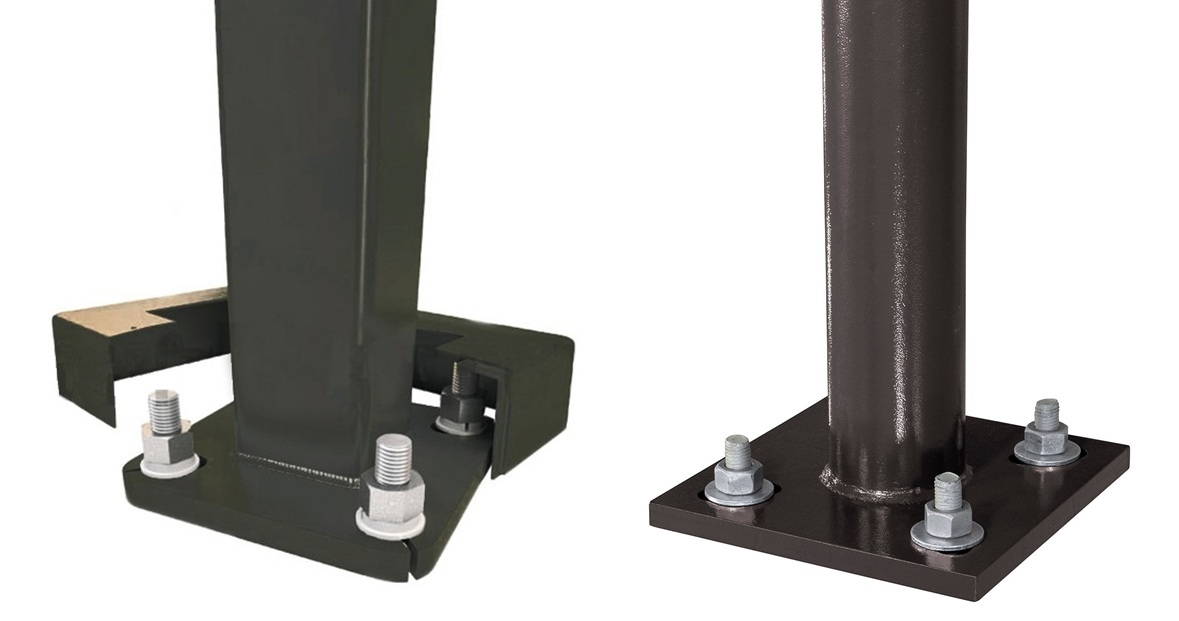Light poles are like trees. Taller trees have a larger diameter, which increases as they grow. If a tree grows taller without increasing its diameter, it won’t stand for long because the wind will easily blow it over due to its smaller (and weaker) base.
Unlike trees, light poles are hollow in the middle. They must be hollow to allow their light fixtures (and/or security cameras) to be wired at the top. This means that the width or diameter of the pole is not the only consideration when determining its ability to safely handle wind and load conditions. You must also consider the wall thickness of the shaft. The width or diameter of the pole will not matter if the walls are too thin.
Steel light poles are significantly stronger than aluminum light poles. An aluminum light pole is lightweight, which makes it easier to transport and install than a steel light pole. However, steel’s superior strength makes it ideal for many applications.
Despite their superior strength, a steel pole’s wall thickness is important when choosing the best light pole for your application. This article will provide you with all the information you’ll need about it to help with the needs of your lighting project.
What Is Steel Light Pole Thickness and Why Does It Matter?
The wall thickness of a steel light pole refers to the thickness of the steel plate used to form it. It is a crucial factor in determining a pole’s strength, durability, and performance in various environments.
Steel pole shafts come in several widths/diameters, and wall thickness will vary based on the shape of the pole. Four basic shapes are available for steel poles: round straight, round tapered, square straight, and square tapered.
- Straight poles have the same width/diameter at the base as at the top.
- Tapered poles are wider at the base and narrower at the top.

Round poles and tapered poles provide better wind resistance than their counterparts, with round tapered poles having the most wind resistance.
Selecting the correct combination of shaft width/diameter and wall thickness will ensure the structural stability of the pole.
What Are the Standard Thicknesses for Steel Light Poles?
Steel gauge thickness is a standardized method of measuring and categorizing thin steel products. As the gauge number increases, the material thickness decreases. Gauge numbers range from 1 to 36, with higher numbers indicating thinner sheets.
The most common gauges used to measure steel light pole thickness are as follows:
- 11 Gauge = 0.120” (typically used for 8’-40’ poles)
- 7 Gauge = 0.188” (typically used for 20’-70’ poles)
- 5 Gauge = 0.219” (typically used for very tall poles like 70’)
Common light pole widths/diameters are 4, 5, and 6 inches. 7-inch and higher widths/diameters are less common and are used for taller light poles. The best light pole gauge for your project will depend on various factors, including its application, pole height, and pole diameter.
How Does Steel Light Pole Thickness Affect Wind Resistance?
Steel light pole durability is increased with thicker walls. Thicker poles will provide better resistance to wind. This is especially important in environments such as:
- Coastal areas that experience hurricanes and where poles are exposed to salty and humid conditions that contribute to higher corrosion risks.
- Mountainous or open landscapes that experience high wind conditions.
Light poles with heavy loads will require thicker walls. Increased weight and EPA (Effective Projected Area) due to multiple light fixtures mounted on the pole will create more stress, increasing safety risks.
More info: How EPA Can Influence Light Pole Buying Decisions
Additionally, advanced coatings and finishes can be applied to make a steel pole more corrosion resistant, such as powder coating and galvanizing.
How Does Steel Light Pole Thickness Impact Cost and Installation Requirements?
A steel light pole’s thickness will influence its price. Thicker poles will be more expensive, including the cost of installation. The thickness of a steel light pole also affects installation requirements due to its increased weight. Thicker poles will be heavier and require a more solid foundation to ensure safety and reliability. A balance between upfront costs, long-term durability, and maintenance savings must be struck to meet customer requirements without being more expensive than necessary.
What Industry Standards Govern Steel Light Pole Thickness?
There are key industrial light pole standards that help determine the appropriate thickness for different applications. These standards include:
- American Association of State Highway and Transportation Officials (AASHTO) light pole wind load ratings. AASHTO is a nonprofit association that represents transportation and highway departments in the 50 states, the District of Columbia, and Puerto Rico.
- American Society for Testing and Materials (ASTM) material requirements. The ASTM is an international standards organization that develops and publishes voluntary consensus technical standards for a variety of materials, products, systems, and services.
LightMart Can Help
Choosing the right light pole thickness is a critical factor when determining your outdoor lighting project needs. The details in commercial light pole specifications will help with light pole strength comparisons, but it’s recommended that you reach out to our knowledgeable staff to ensure that you select the right one. Contact us today!
David DeWald is the E-Commerce Marketing Specialist at LightMart. He has been working in the industrial and commercial lighting industry since 2013 and is based in the greater Chicago area. David specializes in digital product management, web content writing, and product marketing. He regularly publishes lighting industry-related articles on the LightMart blog. You can visit his LinkedIn profile here.
